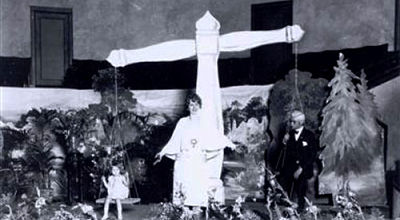HISTORIC: Aimee Semple McPherson’s Ministry Innovations
The revival continued at Angelus Temple while I was there and when I was absent on the evangelistic field. Scores of churches were affiliating with the International Church of the Foursquare Gospel, which had been incorporated in 1927.
The Foursquare movement was growing in the U.S., and we were sending out missionaries overseas to Latin America, Africa and Asia. At Angelus Temple, I conducted my full schedule of services, plus teaching five times each week in the Bible school, which now was called L.I.F.E.—Lighthouse of International Foursquare Evangelism.
By now, Angelus Temple was beginning to appear a bit shabby. The biggest project in the remodeling of the temple was the installation of the beautiful proscenium arch flanked by two choir lofts. This change afforded greater opportunity for the presentation of my illustrated sermons and all of the sacred operas the Lord gave me.
The development of this type of message came as a result of my disappointment that many left my meetings unconverted, in spite of the fact that hundreds and sometimes thousands flocked to the altars. The thought struck me that perhaps if people could see the messages as well as hear them, more would come to Jesus.
In the beginning, the illustrations were quite elementary compared with their later development. My first sermon to be presented in this way was titled, “Weighed in the Balances.” A large pair of scales was erected on the platform, over which a structure of wood canopied by velvet was built. Inside, a man was hidden.
I placed toys representing worldly amusements on one of the scale pans: a toy automobile to represent a joyride, a little house for a dance hall, a miniature oil derrick to represent the search for worldly riches, and so forth. As each object was added, the operator inside would tip the scales further downward.
Then a tiny girl clad in white and carrying a huge family Bible came forward. With the aid of a chair and a lift, she got into the opposite pan. The pan with the girl was lowered. The illustration brought to the hearts of the people the assurance that the Bible, when received as a little child, outweighs the world with all its riches and amusements, no matter how high they are piled.
As time passed, these sermons were worked out much more elaborately and effectively. Beautiful paintings and pastel lightings, planned and prepared by artists and construction experts, were brought into use, and the musical programs were coordinated with the themes of the messages.
Through the years, these illustrated sermons proved to be a joy to the hearts of thousands, besides a delight to the eye and ear. Through them, countless souls who otherwise might not have come to Christ were born into the kingdom of God.
Forty days before Christmas in 1939, God gave me the idea of Regem Adorate—“O Worship the King”—my first sacred opera. It commenced with the creation and fall of man, and continued to the Christmas story. The opera had eight showings at the Temple.
Other sacred operas followed as the years ensued: The Iron Furnace, The Crimson Road, The Rich Man and Lazarus. And individual songs multiplied. Sometimes incidents in my ministry prompted a song, such as when someone commented that I could not be sincere, because I smiled so much on the platform. So I wrote, “Should Christians Smile?”
Another interesting event resulted in my song, “In the Center of God’s Will.” This I wrote on a paper sack retrieved from the floor of a railroad train when I heard newsboys hollering an extra heralding that I had been killed in an airplane crash. (I had missed that plane and taken the train.)
Used with permission from the Foursquare Church. Click here to read the original article.




























































